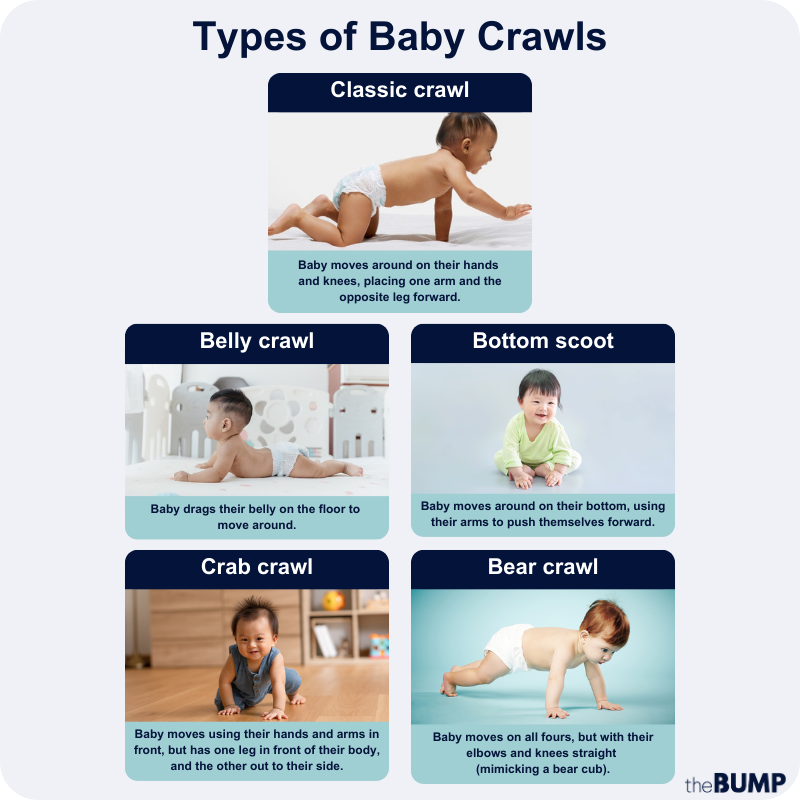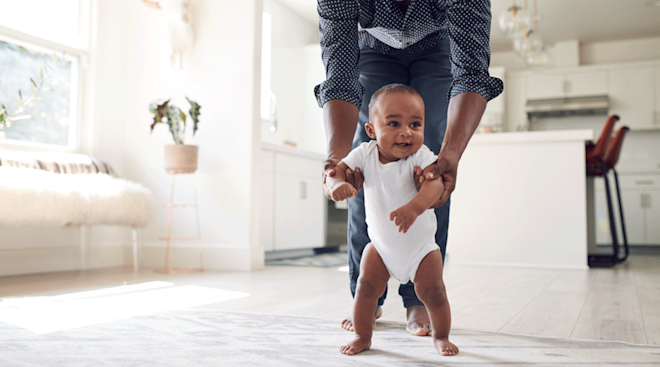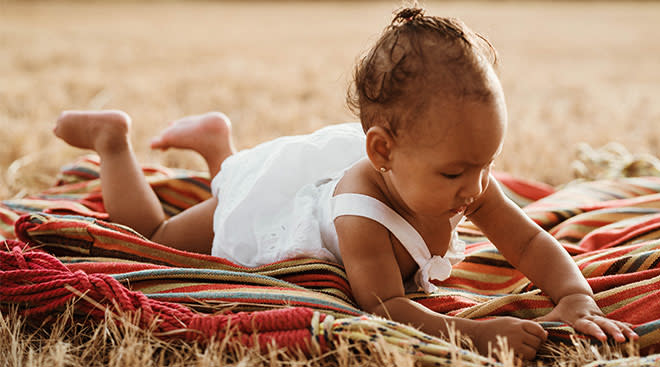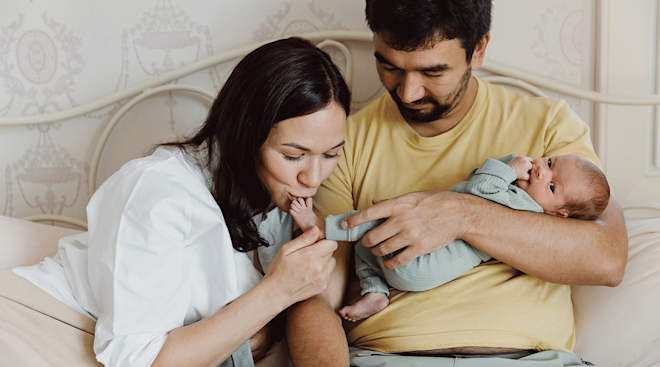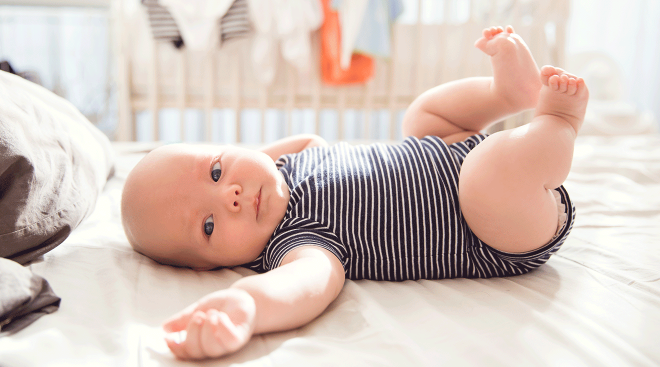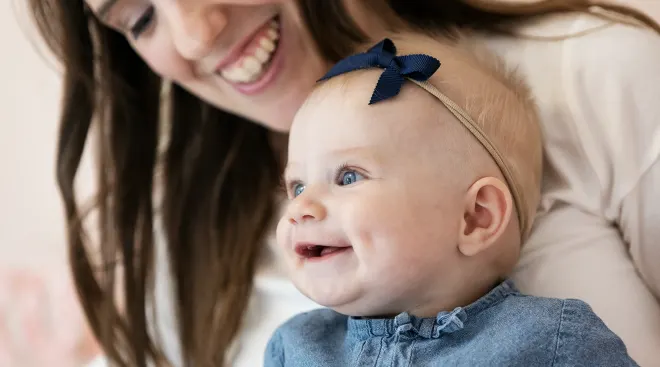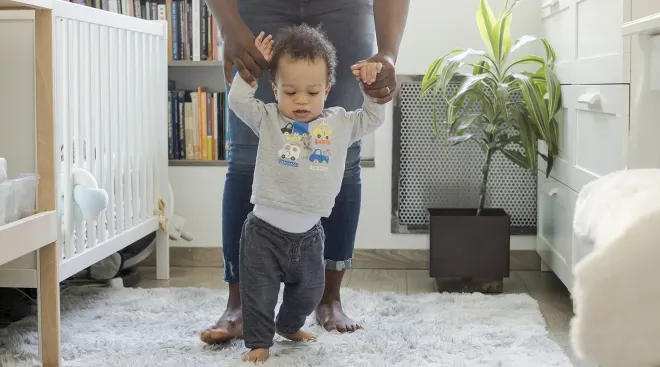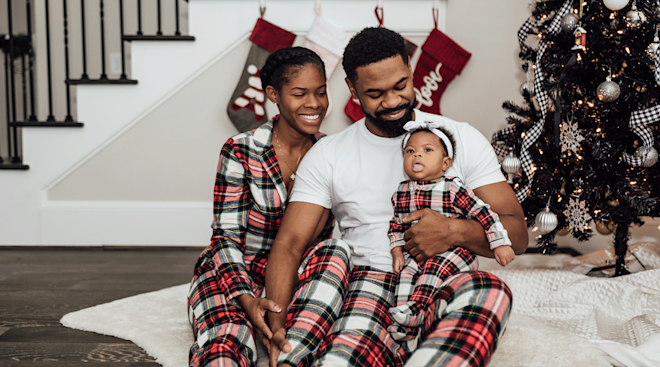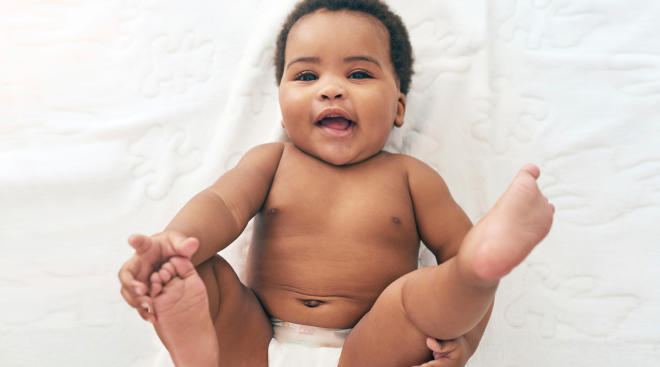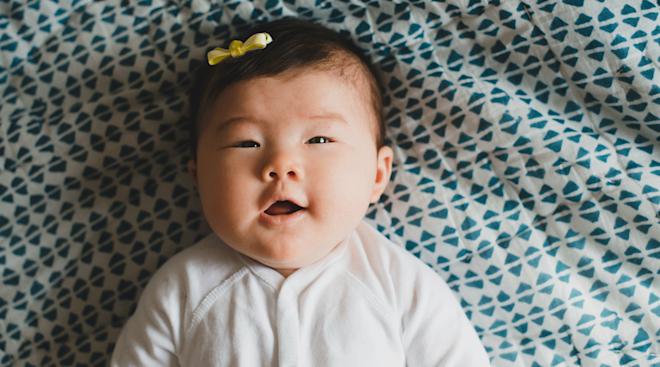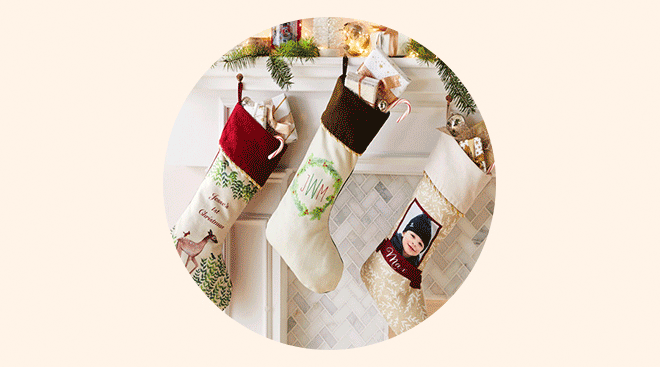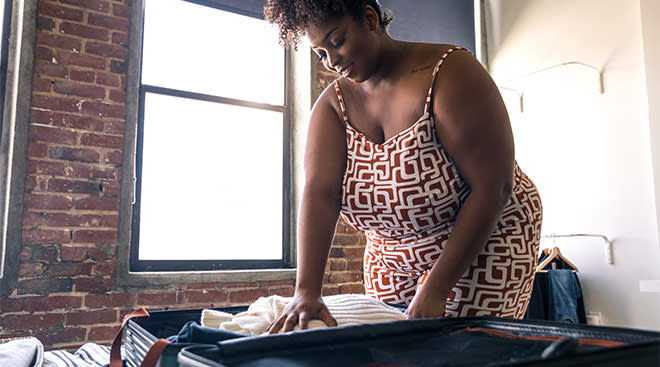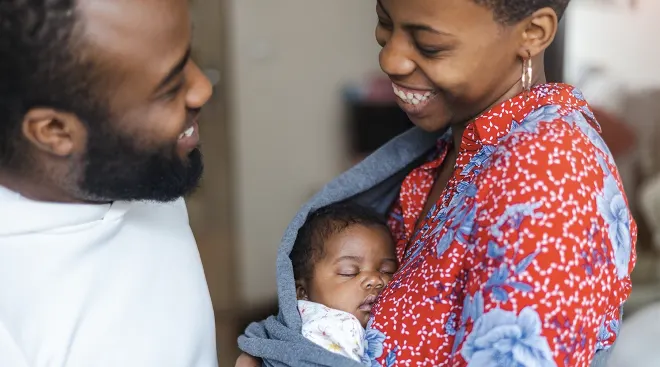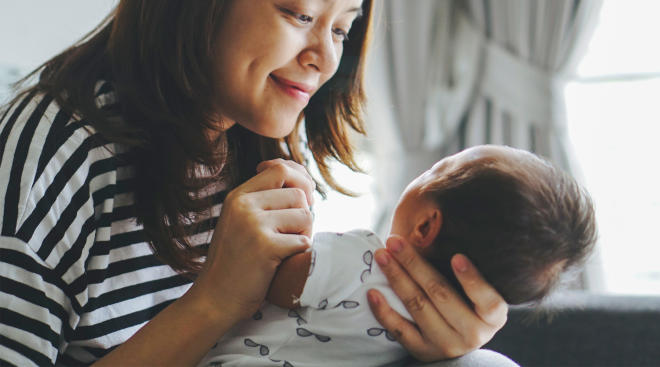When Do Babies Start Crawling?
Watching baby start crawling is undoubtedly the cutest thing ever—so it’s no surprise most new parents wonder: When do babies start crawling? A belly lurch forward, a backward scramble—crawling is baby’s first attempt at moving around independently and a natural next step after some key developmental milestones. However, it’s important to note that crawling itself is actually no longer considered a milestone by the American Academy of Pediatrics (AAP) and it’s not considered a precursor to walking, adds Denise Scott, MD, a pediatrician in Oklahoma. In our baby crawling guide below, experts explain why and answer all your top questions, including at what age babies crawl, signs to look for and how you can help.
- At what age do babies crawl? Babies can start crawling anywhere from 6 to 12 months, with the average age for crawling being 8 to 10 months.
- Your little one may be ready to start crawling if they’ve mastered other aspects of muscular control, such as holding their head up, rolling over and sitting independently.
- Not all crawling styles are the same; there are many different ways for baby to get around.
- It’s normal for some babies to skip crawling entirely and go straight to standing and walking, which is why crawling is no longer considered a major developmental milestone.
So when do babies start crawling? Is there a typical age for o babies to crawl? According to the AAP, usually, babies start crawling anywhere from 8 to 10 months old, but some may start as early as 6 months. While many new parents stress about when their baby will start to crawl and whether they’re keeping up with their peers, the reality is that there’s no set timeline for baby crawling. Baby has to master some other milestones first (more on this below), and each infant progresses at their own speed—so don’t worry if your little one seems completely content staying seated for now. In fact, some babies skip crawling altogether and go straight to standing, cruising (holding onto furniture while taking steps) and walking.
Instead of fretting over what age babies crawl, keep your eyes out for indications that your child is ready to move. There are a few signs baby is ready to crawl that’ll clue you in that it’s time to grab the camera.
Like so many motor developments, baby crawling is all about muscular control. In order to begin crawling, baby first has to master head control, then rolling over on their own and sitting up without any help (which usually happens around 6 to 8 months). “Look for your baby to sit upright with pretty good control and no support,” says Ashanti Woods, MD, a pediatrician at Baltimore’s Mercy Medical Center.
At first, baby will place their hands down to keep from falling and may even put them between their legs to lean on them for support—a position known as a “tripod sit.” As your little one gains control of their torso, they’ll use their hands less for support and more for exploration, reaching for toys and other items just out of their reach. The more baby does this, the stronger they’ll get.
Eventually, baby will pull themselves onto their tummy from a seated position. “Once you start seeing them resting face down on their hands with their butt raised high in the air, that’s usually a sign they’re trying to move,” Woods says. At this point, your days with an immobile baby are numbered, as your little one will soon begin propelling themselves forward in some form of baby crawling.
James occasionally gets up on his hands and knees and rocks back and forth a few times, then flops back down on his belly. I think it's going to be a while longer for him (which I'm fine with because we haven't babyproofed anything yet!).
In the beginning, those first attempts at crawling may be hard to pick up on. A crawling baby might start out by “creeping,” which means they drag their belly and legs by using just their arms. Baby may also scoot their bottom along the floor, roll from point A to point B or even slide backward before moving on to the traditional on-all-fours crawling. Or, baby may get on all fours and just rock back and forth in place. No matter what approach baby takes, rest assured, all of these stages of baby crawling are normal (not to mention adorable!).
Of course, one baby’s preferred style of crawling may look completely different than another’s—and that’s okay. From the classic crawl to the bear crawl, tripod crawl and belly crawl, babies will find a way to move around that feels most comfortable for them. There’s no right or wrong way. “If there’s a way people can move, there’s probably a baby who’s done it,” says Michael McKenna, MD, a pediatrician at Riley Hospital for Children at Indiana University Health. These are some of the most common types of baby crawling, according to the AAP:
-
Classic baby crawl. While putting weight on the hands and knees, baby moves one arm and the opposite leg forward in tandem. Also called “cross-crawling,” this type of crawl helps teach baby balance.
-
Bear crawl. A variation on the classic crawl, the bear crawl is when baby moves on all fours but keeps the elbows and knees straight, which makes them look like—you guessed it—a little bear cub. This is definitely one of the more humorous types of crawling!
-
Belly crawl. Also known as the “commando crawl,” this is when baby drags their belly along the floor as they move. Like the classic baby crawl, it’s another common way for your crawling baby to get started.
-
Crab crawl. You’ll spot this rather interesting crawl when baby uses their hands and arms to scurry sideways or backward. Baby will also push themselves along with just one leg out to the side while keeping the other leg bent in front of their body, which adds to the funny, crablike effect.
-
Bottom scoot. In this type of baby crawling, baby scoots around on their bottom and uses their arms to propel themselves forward.
-
Rolling crawl. Now a master roller, baby makes a series of 360s to get wherever they need to go. It’s not exactly baby crawling, but just “roll” with it—after all, it’s pretty adorable!
-
Tripod crawl. This baby crawling style occurs when baby uses two hands and one knee to scoot across the floor. This leg usually does all the work, while the other leg hangs back and takes it easy.
-
Leapfrog crawl. With this type of baby crawling, baby looks like, well, a leaping frog. The pose involves baby getting on hands and knees, bridge-style, and then thrusting forward to make headway.
My little one is almost 11 months now. He’s still army crawling, and I do consider it crawling—it gets him places, so it counts to me. All my family and in-laws think it's funny that he does it that way…I'm kind of glad he does the army crawling… He isn't as fast compared to if he was up on all fours (although he’s [still] pretty fast).
Wondering how to help baby crawl? You’re in luck: The experts note there are several ways to encourage baby to crawl and get moving.
Encourage tummy time
The best thing you can do is offer lots of opportunities to practice tummy time, which simply involves placing baby on their stomach and allowing them to move around and begin exploring the world around them. This mini workout will help baby strengthen their neck, back, core and shoulder muscles and master head control—two foundational essentials for baby crawling. Plus, all that time face down will help baby get used to and comfortable being on their stomach. With plenty of tummy time practice, baby will be scooting along in no time. (What’s more, tummy time can also help alleviate gas—a win-win if you ask us.)
Offer support
Along with tummy time, you can also help baby stand up by placing your hands under their arms so they’re putting all their weight on their legs and thighs. This simple exercise wakes up those little-used muscles in baby’s lower extremities. Or, you can work on helping baby sit upright, which engages pelvic and back muscles. “To crawl, you need both the lower extremity muscles and the ab muscles,” Woods says. Try a game like peekaboo or patty-cake to keep baby interested (and sitting upright longer). Baby will get more familiar with using and engaging these muscles and continue using them until they work their way up to a crawl and eventually a walk stance.
My first was exclusively a booty scooter. He never crawled the traditional way. He didn’t need to. He was so effective at getting where he wanted to go by pushing forward with his arms and sliding with his bum. We called it the ‘butt scooch!’
Praise baby and offer incentives
Don’t discount the value of a good incentive. Babies don’t need any special toys or gear to learn to crawl, but parents sometimes like to introduce one as they figure out how to teach baby to crawl. A little praise and encouragement on your end can go a long way in supporting baby’s progress. A play tunnel can spark baby’s curiosity and entice them to get moving—just keep in mind that you might need to crawl through it first a few times to show baby how it’s done.
McKenna also suggests placing a favorite toy just out of reach and encouraging baby to crawl or scoot toward it. Anything that’s visually stimulating makes a great learn-to-crawl toy—try activity balls that roll around and make sounds, play music or flash lights. But, McKenna adds, “anything you can use to engage your child in activities is good.”
Create a safe crawling environment
As soon as you have a baby on the move, anything is fair game. Baby will want to reach for, tug on, pick up and taste anything they can get their little hands on. That’s why it’s so important to finish babyproofing (if you haven’t already) and make sure you’ve covered any and all potential danger zones before you’ve got a crawling baby on your hands. “The best way is to get on your hands and knees and see what you can find,” McKenna says. That way, you assess the room from baby’s point of view and see what might be tempting or enticing.
In addition to sharp corners and breakables, look for choking hazards (coins on the floor, button batteries, a dropped thumbtack or pin); easily accessible chemicals (household cleaners, dishwashing pods); dangling cords or anything baby can yank on or pull down onto themself; and any exposed outlets. Also, don’t forget to secure or lock any cabinets and drawers that baby could potentially open. And be sure to install a baby gate at both the top and bottom of your stairs, and double-check that all heavy furniture and electronics are securely anchored to the wall or floor. As exciting as it is to have a crawling baby on your hands, it can certainly open up the floodgates for potential accidents if you’re not properly prepared.
It’s not uncommon for baby to crawl backwards at first, so don’t worry if this happens! My son was crawling backwards until he was around 9 months, which was hilarious. We encouraged him to crawl to us by shaking a toy, and he figured it out at his own pace.
Contrary to popular belief, the crawling milestone is actually not a major one. Some babies bypass crawling all together and move right on to standing and walking. If baby doesn’t crawl, it’s generally not a sign that they’re about to stop hitting other major developmental milestones.
That said, there are other ways to gauge if baby’s progressing as they should overall. If by 7 months old, baby feels loose or floppy in your arms or refuses to bear any weight on the legs after multiple attempts to support them while standing, a call to your pediatrician may be in order. “We expect muscles to bulk up around that age,” says Woods. “When babies have a low tone or are very floppy, that could be suggestive of other things.” Plus, consult your pediatrician if a handful of months have passed with no new developments, as your little one could be facing developmental delays. (But know that when it comes to such issues, early intervention can make a big difference.)
At the end of the day, if you’re worried about baby crawling, follow your gut. “Parents have a decent sense of when something is wrong with their child,” McKenna says. “There’s not a problem every time, but if you’re worried or have questions or think something doesn’t feel right, talk to your doctor.”
Frequently Asked Questions
How early can babies crawl?
According to Scott, there’s no clear answer here. Again, a typical crawling age for babies is anytime between 6 and 12 months, with the average age being 9 months, but there’s also a big range, as “some babies skip the crawling stage and go straight to walking,” she adds. Baby being early or late to the crawling game doesn’t really mean anything.
Is it normal for baby to crawl backwards?
Babies may crawl in several fashions, including crawling backwards on their belly or with one leg—and all of it’s normal, Scott says. “Babies may get up on all fours and lunge forward, do a bear walk, crawl with one knee and drag the other leg behind, or scoot on their bottom—while some skip this stage altogether.”
Why is crawling no longer considered a milestone?
In 2021, the CDC and AAP updated their guidelines for milestones, basing their updates on what 75 percent or more of the population would be achieving by specific ages. As part of the update, crawling was removed as a milestone. “There was a lack of evidence to support crawling (which takes many forms) as a reliable indicator of development,” Scott explains.
Can diapers delay crawling?
A 2013 report claims that diapers may delay crawling and infant walking, as they’re bulky and may negatively affect baby’s already wobbly, wide stance. However, Scott says there’s little truth or evidence to support this claim, and it’s unlikely that diapers delay crawling.
Does delayed crawling signal delayed walking?
Delayed crawling doesn’t signal delayed walking. “Most parents will anticipate that their infant will crawl and most will do so by a year,” Scott says. “Should an infant skip this stage and make attempts to pull to stand and walk, there’s no cause for worry. It’s okay to skip the crawling stage if other developmental skills are on track.”
Please note: The Bump and the materials and information it contains are not intended to, and do not constitute, medical or other health advice or diagnosis and should not be used as such. You should always consult with a qualified physician or health professional about your specific circumstances.
Plus, more from The Bump:
Michael McKenna, MD, is a general pediatrician at Riley Hospital for Children at Indiana University Health and Ascension Medical Group in Zionsville, Indiana. He earned his medical degree from Indiana University School of Medicine, where he also completed his internship and residency.
Denise Scott, MD, is a pediatrician and pediatric endocrinologist based in Oklahoma with over 30 years of experience. Certified in culinary medicine, Scott also runs the blog Feed Future Health and is the author of Feed Your Child’s Future Health: Prevent Disease Before It Starts. She received her medical degree from the University of Texas Medical Branch and completed her residency at the University of Oklahoma Health Sciences Center with a fellowship at the National Institutes of Health.
Ashanti Woods, MD, FAAP, is an attending pediatrician at Mercy Medical Center in Baltimore, Maryland. He earned his medical degree from Howard University College of Medicine in Washington DC and completed his residency at the University of Maryland Hospital for Children in Baltimore, Maryland.
American Academy of Pediatrics, Movement: Babies 8 to 12 Months, April 2021
American Academy of Pediatrics, Crawling Styles, September 2021
Developmental Science, Go Naked: Diapers Affect Infant Walking, February 2013
Real Parent Perspectives
- nicolita14w
- evanzmom11
- Lauren Barth
- Natalie Goncharova
Learn how we ensure the accuracy of our content through our editorial and medical review process.
Navigate forward to interact with the calendar and select a date. Press the question mark key to get the keyboard shortcuts for changing dates.

































